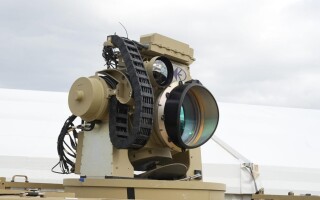Small UAS swarms and battle management: The evolving warfare landscape
StorySeptember 10, 2024

Modern militaries face a new friend and foe: small uncrewed aircraft systems (sUASs). While these small craft enhance mission capabilities, they also pose serious threats when used by the enemy. The presence of sUAS swarms demands a shift to autonomous, artificial intelligence (AI)-driven countermeasures that optimize sensor resource management for smart real-time decision-making and situational awareness. Sensor resource management for the battlefield optimizes communications between systems enabling enhanced command, control, communications, computers, intelligence, surveillance, and reconnaissance (C4ISR); UASs and sUASs; position, navigation, and timing (PNT); electronic warfare (EW) capability; and connection to a larger defense network.
Today, military operations are being impacted on many technological fronts and small uncrewed aircraft systems (sUASs) have become game-changing tools, reshaping both tactical and strategic approaches. Their ability to carry out missions autonomously, supported by longer battery life and strong communications networks, has significantly increased their range, endurance, and flexibility. However, these technological advancements have also provided adversaries with enhanced capabilities, enabling them to use sUASs for gathering intelligence, carrying out attacks, and even potentially spreading chemical, biological, or radiological agents, thereby posing a serious obstacle to operational readiness.
One particularly daunting threat is the emergence of sUAS swarms – large, coordinated groups of drones that work together to overwhelm or wear down targets through persistent ongoing attacks. These swarms have notable advantages over single or small groups of UASs, including their attritable nature, greater resilience, and high adaptability. When one or more of these small UASs are taken out, the remaining ones could share information, keep communication lines open, and theoretically reassign mission objectives on the fly, adjusting to the changing battlefield conditions in real time.
Limitations of conventional counter-sUAS methodologies
Historically, counter-sUAS systems have relied on manual operation, providing operators with detailed sensor and weapon data – and a lot of it. This information glut not only complicates operator interactions but also slows down accurate decision-making, especially when facing sUAS swarm threats.
As autonomous drones coordinate their actions to achieve their goals, defensive forces must leverage increased decision support and automation of counter-sUAS resources to maintain an advantage. Sensor management must be closely tied to battle-management objectives, based on relevant data and timing. At the same time, battle-management support tools must consider the complex relationship between sensor control and weapon deployment.
Harnessing AI and automation: the path to operational dominance
The use of advanced algorithms and artificial intelligence (AI) has completely changed how we process and analyze the massive amount of data in sUAS swarms. With advanced pattern recognition, anomaly detection and predictive modeling, smart counter-sUAS systems can coordinate sensors and weapons to better detect, track, identify and engage threats. This gives decision-makers real-time, actionable intelligence when dealing with large groups of hostile drones.
Optimizing sensor resource management
Sensor resource management involves assigning sensors to optimize detection, tracking, and data fusion.
Traditional counter-sUAS systems often require humans to manage sensor tasking, leading to slowdowns and longer response times during attacks. Automated sensor management, on the other hand, enables software to handle the detailed sensor tasks while human operators focus on high-level guidance and oversight, making the whole process more efficient.
Automated sensor resource management has several advantages. First, it frees up operators to focus on higher-level planning and tactics in complex scenarios. It also enables rapid decision-making against multiple, dynamic threats by intelligently determining sensor dwell times and target-revisit intervals. This approach reduces risk to forces – who may be operating from the ground or in the air – by deploying automated sensing assets on unmanned robotic platforms, away from personnel. Additionally, it enables automated target cueing, where optical systems are directed based on radar-detection data as targets become visible, all without human intervention. Finally, automated sensor resource management supports low-signature mission concepts where systems scan for threats and activate radar resources only when needed, reducing the threat to those who may be below or above while maintaining effective counter-sUAS operations.
With the help of AI and algorithms for coordination, automated sensor resource management enhances the accuracy and adaptability of defense operations, ensuring optimal utilization of sensor assets and intelligence.
Optimizing weapon-target assignment
In battle management, it is important to be strategic in deciding which weapons to use against which targets and at what time. The weapon-target assignment “problem” involves figuring out the best way to distribute different weapons systems to targets in order to maximize the damage inflicted on the enemy. In scenarios with multiple threats, this decision-making can be a challenge for humans, who must quickly assess how to engage within seconds to minutes.
Automation in battle management enables systems to assess all available resources and prioritize actions based on the mission’s goals, rather than just responding to the most obvious threat. It enables real-time, evolving development of battle plans, using cutting-edge techniques in combinatorial optimization and AI to support tactical decision-making. These plans are adaptive, automatically updating as new intelligence is gathered and threats are identified, with sensor and weapons resources dynamically reassigned as needed. The system also enhances weapon-target assignment by leveraging the unique capabilities of each asset to achieve the best overall solution, integrating models for sensors, weapon-threat geometry, ballistic-missile trajectories, and interceptor guidance models. Moreover, such automation enhances strategic reasoning against sUAS adversaries, developing sophisticated responses to drones that actively adapt to countermeasures.
By automating key aspects of battle management, commanders can speed up combat operations and maneuvers. Decision speed aids in making the best decisions about which targets to hit and when to provide fire support, which is changing how warfare is conducted as information becomes more abundant. (Figure 1.)

[Figure 1 ǀ Automation of key aspects of battle management can enable commanders to make better decisions on combat operations and maneuvers.]
Integrating sensors in battle management
Drone swarms generate an overwhelming influx of information, leaving operators inundated with data and insufficient time for effective decision-making. By implementing a solution that coordinates the management of sensor and weapons resources towards a unified outcome, forces can transform vast quantities of data and an overwhelming array of options into actionable intelligence.
When sensor resource management aligns with battle-management objectives, the combined capabilities exceed what each can achieve alone. Together, they ensure effective engagement and real-time damage assessment in complex, multithreat situations. They also make the most of limited sensor and weapons resources by tailoring responses to meet mission needs and support overall strategic goals. This teamwork lightens the load on operators in fast-paced environments by automating simpler tasks while still keeping the human-control aspect flexible. Using AI and optimization-driven decision support helps battle managers make quicker, smarter decisions and adapt to the most effective course of action in real time.
The future of counter-sUAS operations
The exponential growth of sUAS swarms and the increasing complexity of multithreat scenarios necessitate a fundamental reevaluation of counter-sUAS methodologies. Traditional methods, with their reliance on manual processes and siloed information systems, are not able to effectively tackle the challenges of synchronized, autonomous drone formations.
However, by using AI, automation, and advanced algorithms, modern counter-sUAS systems can seamlessly integrate sensor management and battle management, allocating sensors and weapons more efficiently towards a common goal. This integrated approach not only improves situational awareness and engagement capabilities but also reduces the mental load on operators, enabling quick and informed decisions in fast-paced environments.
As the battlefield continues to change, adopting AI and algorithm-driven counter-sUAS capabilities is essential for maintaining tactical superiority and protecting forces. With intelligent automation, military forces can effectively counter the threats posed by drone swarms, ensuring they maintain critical primacy at the tactical edge.
Dr. Jason Adaska is the vice president of Command and Control (C2) Systems at Numerica and leads a multidisciplinary team responsible for Numerica’s Mimir C2 software platform. Jason has more than 16 years of professional experience in advanced algorithms research, commercial software development, and technical leadership and has deep technical expertise in applied probability, optimization and modern AI/ML techniques. Jason holds a doctorate in applied mathematics from Harvard University and bachelor’s degrees in electrical engineering and computer science from Cornell University.
Numerica • https://numerica.us/







